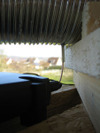I still vividly remember standing in front of a big audience for the first time in 2001 speaking about wireless network evolution. At the time, GPRS was still in it’s infancy, GPRS enabled phones were not yet available and the 384 kbit/s promised by UMTS sounded miraculous to me. Today, five years later, UMTS is a reality and networks have already far surpassed the outlook from five years ago. Mobile Web 2.0 is in everybody’s ears these days and here’s my take on it from the network point of view:
Rudy de Waele recently posted a very good summary of his thoughts on Mobile Web 2.0. From the network point of view Mobile Web 2.0 social applications such as Flickr Mobile, mobile blogs, mobile podcasting, web and AJAX applications, mobile eMail, Widgets, location based services, etc. require one thing: Bandwidth, bandwidth and once again bandwidth. It’s one thing to download a tiny mobile optimized web page and quite another to upload large pictures and podcasts. In the fixed line world, DSL and cable modems have been the enablers on the network side for Web 2.0. For the Mobile Web 2.0 here are today’s and tomorrow’s enabling technologies from the wireless network side:
Today’s Enablers
EDGE: While GPRS was way too slow for most Web 2..0 applications, things got a lot better with the introduction of EDGE about one and a half years ago. EDGE improves GPRS downlink speeds to about 220 kbit/s and uplink speeds to about 100 kbit/s.
UMTS: Here, things are getting really exciting. First networks started operation about two and a half years ago and a data rate of 384 kbit/s in downlink and 64 to 128 kbit/s in uplink direction make the mobile Internet almost feel like over a fixed line connection.
HSDPA and HSUPA: This is the step about which only five years ago I did not even dream about. Only five years after GPRS downlink speeds reached about 35 kbit/s, HSDPA today offers data rates of 3.6 MBit/s. That’s almost 100 times faster than networks were five years ago! With HSUPA, uplink data rates will also get a big push and will exceed 800 kbit/s in favourable conditions. Again, 100 times more than the status quo five years ago.
Future Enablers
Again, I am at a point where I look into the future to get an idea what kind of mobile networks we are going to see in five years from now. HSDPA will keep evolving for some time to come and data rates of over 7 Mbit/s in downlink direction will be introduced in networks in the next year or two.
To increase speeds yet again by a factor of ten will be though. On the other hand, going from GPRS to UMTS was no child’s play either. Current plans for the UMTS successor called LTE (Long Term Evolution) and WiMAX foresee data rates of about 100 MBit/s in downlink and well over 30 MBit/s in uplink. First WiMAX networks are already in the deployment phase, LTE networks will follow in about three to four years.
WiMAX operators will have a crucial role in the development of the wireless web in general depending on whether they will offer their services in an open hotspot fashion or decide to go for a closed 3G like approach. More on this can be found here.
Private and public Wifi hotspots and networks (aka Muni Wifi) will also be an important ingredient for the mobile eco-system in the future. High end mobile devices already include both 3G and Wifi interfaces today. This both off-loads traffic from cellular 2G and 3G networks and offers additional possibilities to Web 2.0 applications today and in the future. It might very well be that in five years from now, 3G access will have become so cheap that most people download podcasts and upload pictures to Flickr wherever they are. In another scenario many people might still prefer up- and downloads multimedia content over their Wifi/DSL connection to and from their mobile device while at home and choose to keep their 3G bill as small as possible. Combined 3G/DSL operators as discussed here are in an ideal position to benefit both ways.
Impact on the Evolution of Mobile Web 2.0
The anytime anywhere Internet has already been promised to us five years ago with GPRS. The limitations financially as well as from a bandwidth point of view, however, were reason enough to prevent widespread adoption. Starting with UMTS and especially with HSDPA, the limitations of the mobile web are more and more dwindling away. Smartphones such as Nokia N or E-series devices, Sony Ericsson’s UIQ devices and Windows Mobile PDAs today have processors, memory and graphics capabilities surpassing those of PCs from 10 years ago. This trend will hardly stop either and in combination with ever faster and farther reaching mobile networks, Web 2.0 and the Mobile Web 2.0 will merge into a single social eco-sphere where people can truly access content and contribute anytime anywhere.
More on the technical side of the evolution of wireless can be found here.




